Abstract
Antibodies to D-lysergic acid have been produced in rabbits and guinea pigs and a radioimmunoassay for the hapten was developed. The specificity of this lysergamide-antilysergamide reaction was determined by competitive binding with unlabeled lysergic acid diethylamide (LSD), psychotomimetic drugs, neurotransmitters, and other compounds with diverse structures. LSD and several related ergot alkaloids were potent competitors, three to seven times more potent than lysergic acid itself. The N,N-dimethyl derivatives of several compounds, including tryptamine, 5-hydroxytryptamine, 4-hydroxytryptamine, 5-methoxytryptamine, tyramine, and mescaline, were only about ten times less effective than lysergic acid, even though these compounds lack some of the ring systems of lysergic acid. The pattern of inhibition by related compounds with various substituents suggests that the antibody receptor site recognizes structural features resembling the LSD molecule. In particular, the aromatic nucleus and the dimethylated ethylamine side chain in phenylethylamine and tryptamine derivatives may assume in solution a conformation resembling ring A and the methylated nitrogen in ring C of LSD. Among the tryptamine derivatives, a large percentage of the most potent competitors are also psychotomimetic compounds.
Keywords: molecular structure, hallucinogenic, rabbit, guinea pig, psychotomimetic
Full text
PDF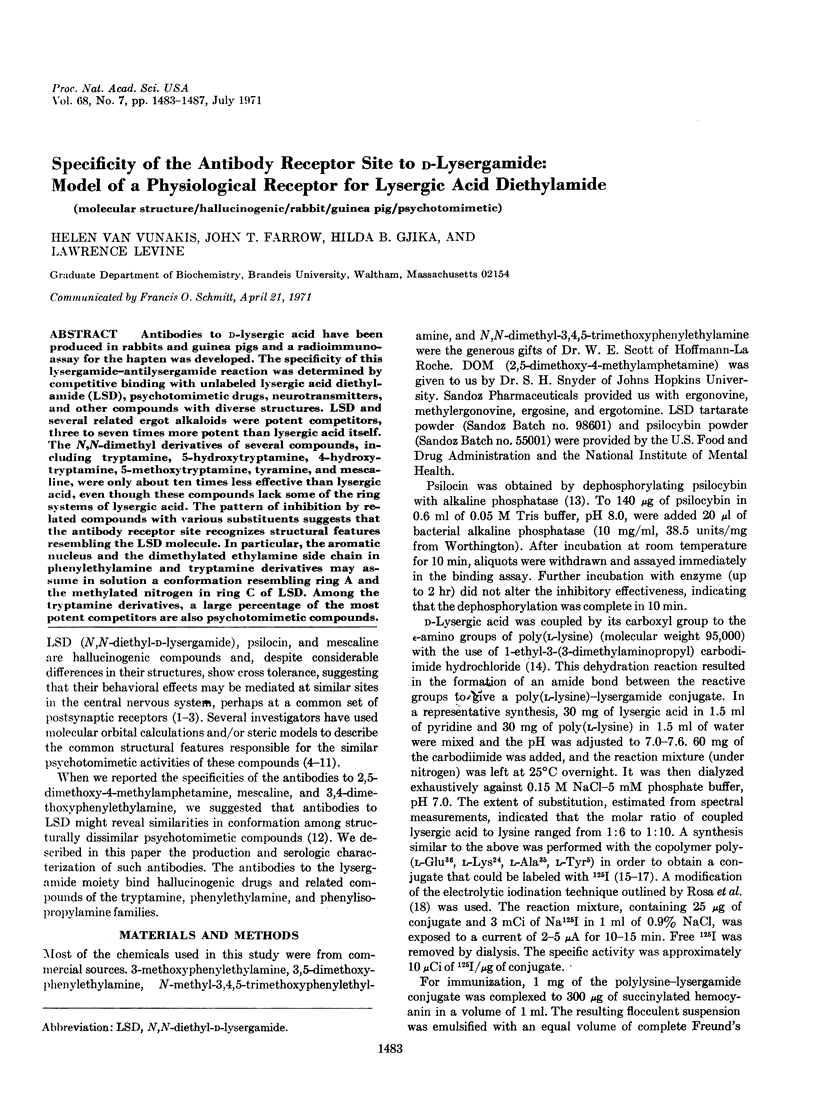
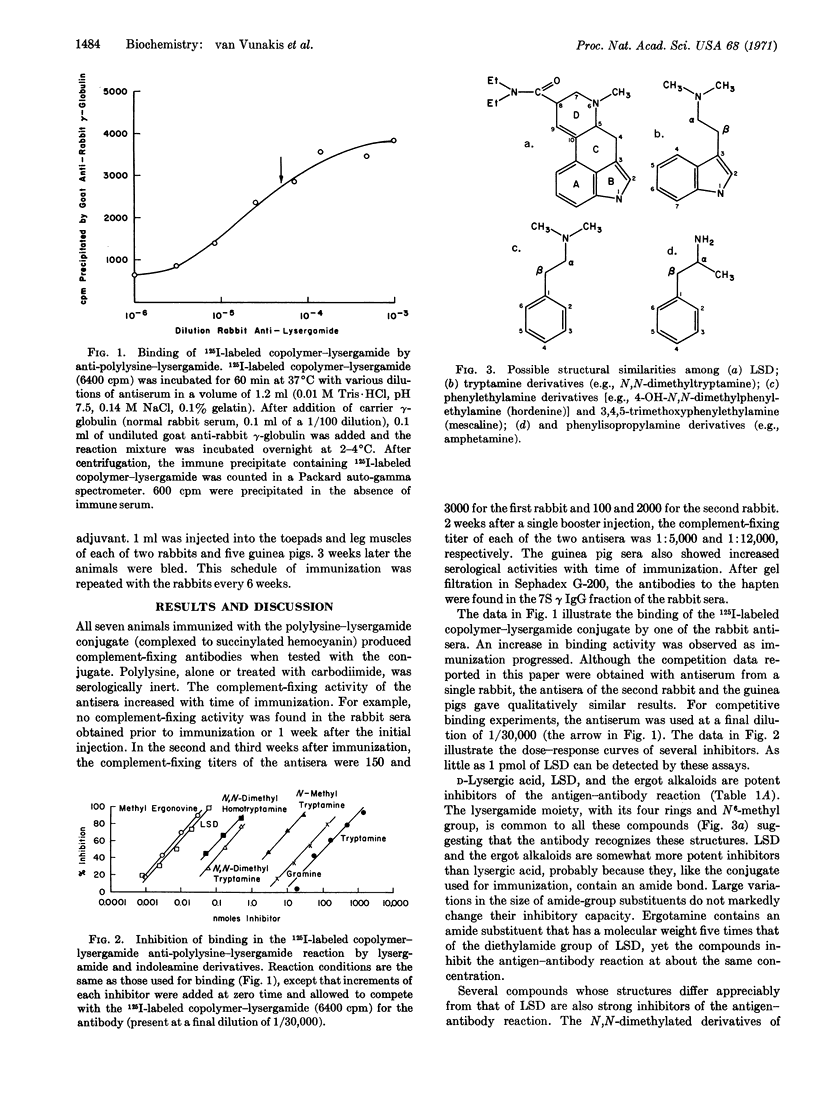
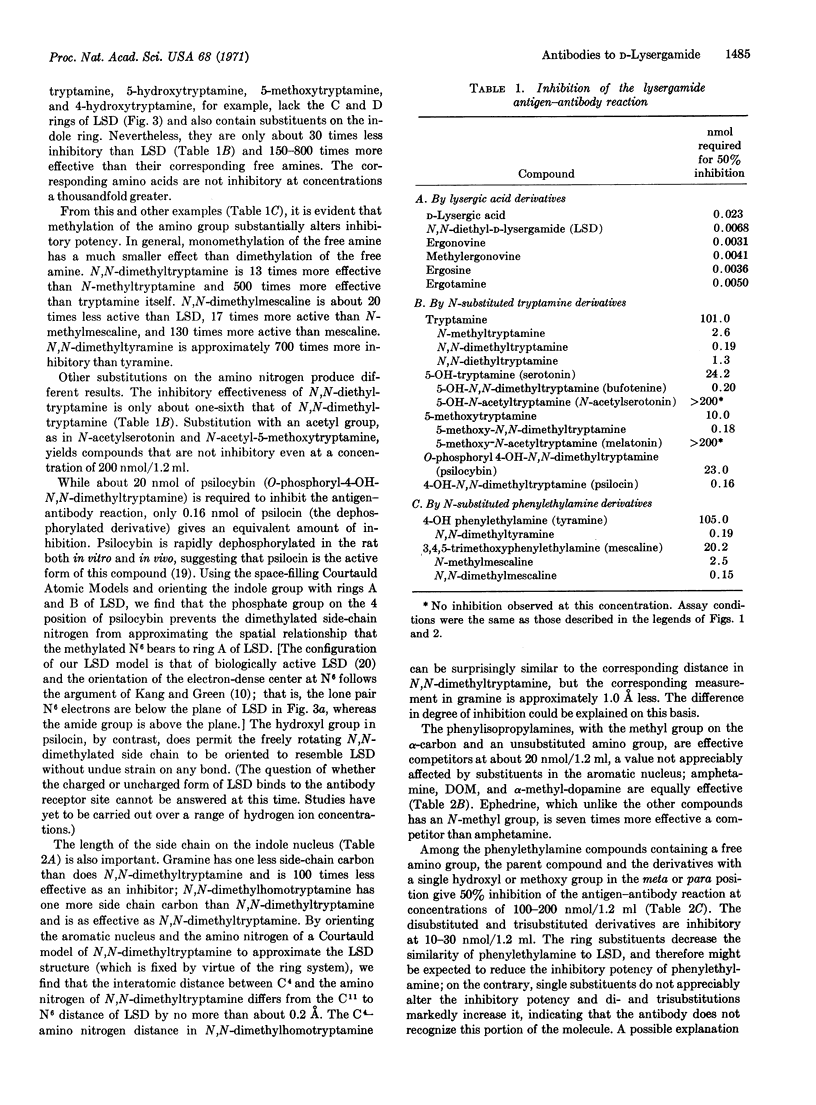
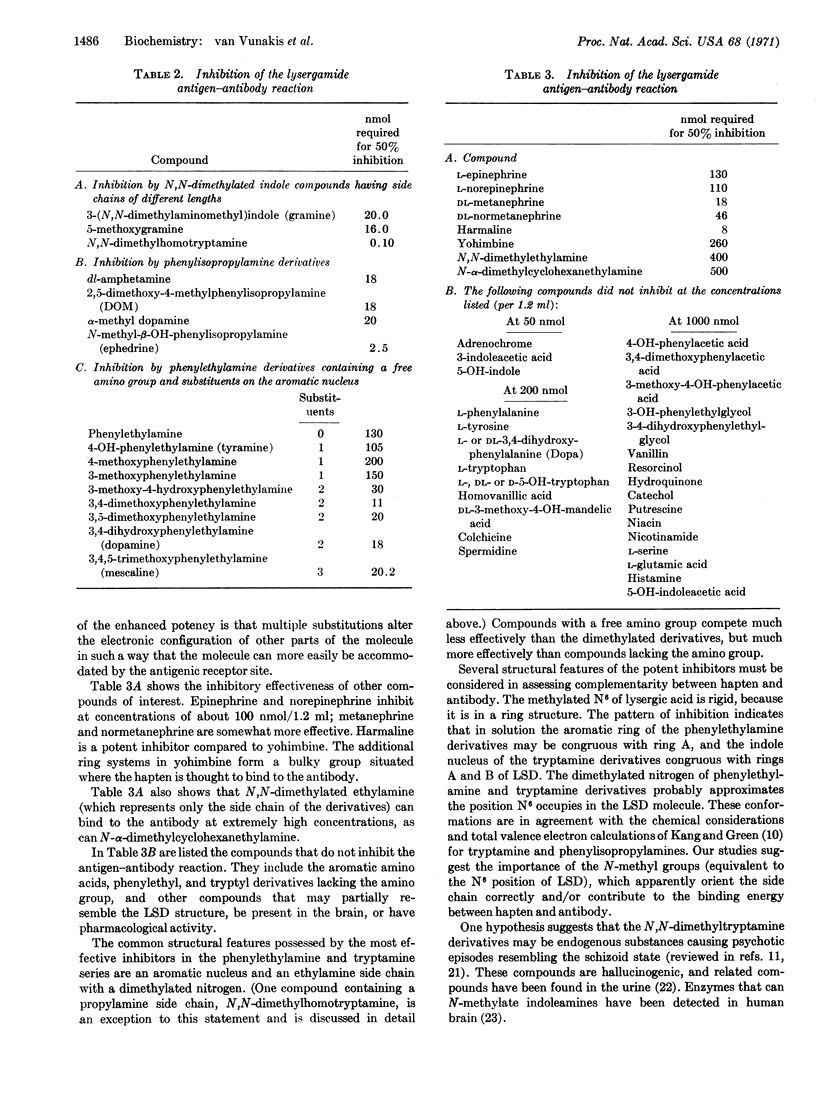
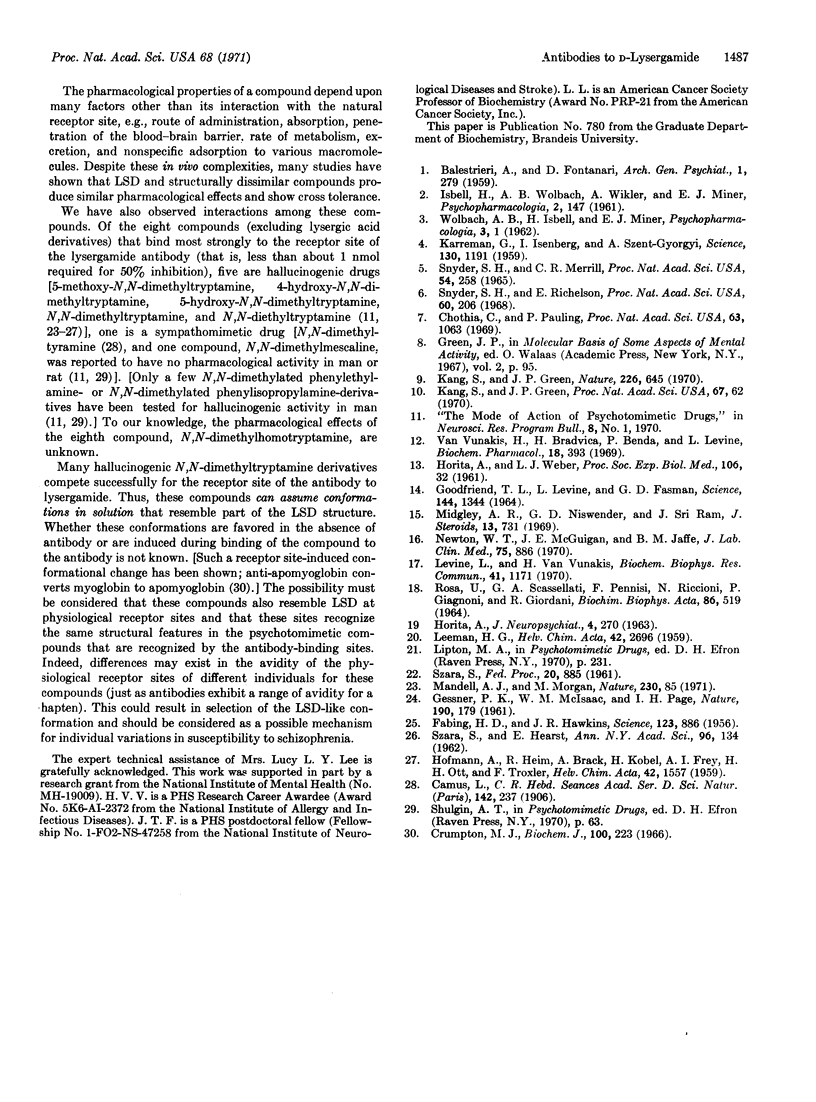
Selected References
These references are in PubMed. This may not be the complete list of references from this article.
- BALESTRIERI A., FONTANARI D. Acquired and crossed tolerance to mescaline, LSD-25, and BOL-148. AMA Arch Gen Psychiatry. 1959 Sep;1:279–282. doi: 10.1001/archpsyc.1959.03590030063008. [DOI] [PubMed] [Google Scholar]
- Chothia C., Pauling P. On the conformations of hallucinogenic molecules and their correlation. Proc Natl Acad Sci U S A. 1969 Aug;63(4):1063–1070. doi: 10.1073/pnas.63.4.1063. [DOI] [PMC free article] [PubMed] [Google Scholar]
- Crumpton M. J. Conformational changes in sperm-whale metmyoglobin due to combination with antibodies to apomyoglobin. Biochem J. 1966 Jul;100(1):223–232. doi: 10.1042/bj1000223. [DOI] [PMC free article] [PubMed] [Google Scholar]
- FABING H. D., HAWKINS J. R. Intravenous bufotenine injection in the human being. Science. 1956 May 18;123(3203):886–887. doi: 10.1126/science.123.3203.886. [DOI] [PubMed] [Google Scholar]
- GESSNER P. K., McISAAC W. M., PAGE I. H. Pharmacological actions of some methoxyindolealkylamines. Nature. 1961 Apr 8;190:179–180. doi: 10.1038/190179a0. [DOI] [PubMed] [Google Scholar]
- GOODFRIEND T. L., LEVINE L., FASMAN G. D. ANTIBODIES TO BRADYKININ AND ANGIOTENSIN: A USE OF CARBODIIMIDES IN IMMUNOLOGY. Science. 1964 Jun 12;144(3624):1344–1346. doi: 10.1126/science.144.3624.1344. [DOI] [PubMed] [Google Scholar]
- HORITA A. Some biochemical studies on psilocybin and psilogin. J Neuropsychiatr. 1963 Apr;4:270–273. [PubMed] [Google Scholar]
- HORITA A., WEBER L. J. Dephosphorylation of psilocybin to psilocin by alkaline phosphatase. Proc Soc Exp Biol Med. 1961 Jan;106:32–34. doi: 10.3181/00379727-106-26228. [DOI] [PubMed] [Google Scholar]
- ISBELL H., WOLBACH A. B., WIKLER A., MINER E. J. Cross tolerance between LSD and psilocybin. Psychopharmacologia. 1961;2:147–159. doi: 10.1007/BF00407974. [DOI] [PubMed] [Google Scholar]
- KARREMAN G., ISENBERG I., SZENT-GYORGYI A. On the mechanism of action of chlorpromazine. Science. 1959 Oct 30;130(3383):1191–1192. doi: 10.1126/science.130.3383.1191. [DOI] [PubMed] [Google Scholar]
- Kang S., Green J. P. Correlation between activity and electronic state of hallucinogenic amphetamines. Nature. 1970 May 16;226(5246):645–645. doi: 10.1038/226645a0. [DOI] [PubMed] [Google Scholar]
- Kang S., Green J. P. Steric and electronic relationships among some hallucinogenic compounds. Proc Natl Acad Sci U S A. 1970 Sep;67(1):62–67. doi: 10.1073/pnas.67.1.62. [DOI] [PMC free article] [PubMed] [Google Scholar]
- Levine L., Van Vunakis H. Antigenic activity of prostaglandins. Biochem Biophys Res Commun. 1970 Dec 9;41(5):1171–1177. doi: 10.1016/0006-291x(70)90209-3. [DOI] [PubMed] [Google Scholar]
- Mandell A. J., Morgan M. Indole(ethyl)amine N-methyltransferase in human brain. Nat New Biol. 1971 Mar 17;230(11):85–87. doi: 10.1038/newbio230085a0. [DOI] [PubMed] [Google Scholar]
- Midgley A. R., Jr, Niswender G. D., Ram J. S. Hapten-radioimmunoassay: a general procdure for the estimation of steroidal and other haptenic substances. Steroids. 1969 Jun;13(6):731–737. doi: 10.1016/0039-128x(69)90069-5. [DOI] [PubMed] [Google Scholar]
- Newton W. T., McGuigan J. E., Jaffe B. M. Radioimmunoassay of peptides lacking tyrosine. J Lab Clin Med. 1970 May;75(5):886–892. [PubMed] [Google Scholar]
- ROSA U., SCASSELLATI G. A., PENNISI F. LABELLING OF HUMAN FIBRINOGEN WITH 131-I BY ELECTROLYTIC IODINATION. Biochim Biophys Acta. 1964 Jun 8;86:519–526. doi: 10.1016/0304-4165(64)90091-1. [DOI] [PubMed] [Google Scholar]
- Snyder S. H., Merril C. R. A relationship between the hallucinogenic activity of drugs and their electronic configuration. Proc Natl Acad Sci U S A. 1965 Jul;54(1):258–266. doi: 10.1073/pnas.54.1.258. [DOI] [PMC free article] [PubMed] [Google Scholar]
- Snyder S. H., Richelson E. Psychedelic drugs: steric factors that predict psychotropic activity. Proc Natl Acad Sci U S A. 1968 May;60(1):206–213. doi: 10.1073/pnas.60.1.206. [DOI] [PMC free article] [PubMed] [Google Scholar]
- Van Vunakis H., Bradvica H., Benda P., Levine L. Production and specificity of antibodies directed toward 3,4,5-trimethoxyphenylethylamine, 3,4-dimethoxyphenylethylamine and 2,5-dimethoxy-4-methylamphetamine. Biochem Pharmacol. 1969 Feb;18(2):393–404. doi: 10.1016/0006-2952(69)90216-0. [DOI] [PubMed] [Google Scholar]
- WOLBACH A. B., Jr, ISBELL H., MINER E. J. Cross tolerance between mescaline and LSD-25, with a comparison of the mescaline and LSD reactions. Psychopharmacologia. 1962 Mar 12;3:1–14. doi: 10.1007/BF00413101. [DOI] [PubMed] [Google Scholar]


